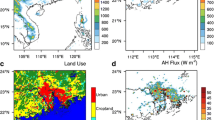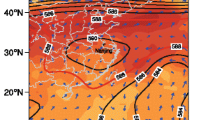Abstract
Anthropogenic heat (AH) is an important part of urban surface energy balance. Although AH affects regional climates through changing land-atmosphere interactions, the climate forcing from AH are not usually calculated in state-of-the-art regional climate simulations. In this paper, the spatial pattern of AH in 20 automatic weather station sites in the Beijing municipal administrative area is parameterized by employing nighttime light data. Two experiments were designed and performed to quantify the influence of AH on the surface balance of energy and water through running the Integrated urban Land Model (IUM). The results show that due to accounting for AH, the simulated LST increases; the net radiation decreases around noon; the absolute value of the ground heat flux increases around noon; the sensible heat flux increases in the daytime; the evapotranspiration decreases around noon and increases in the morning and evening; volumetric soil moisture and soil water storage decrease; aggregated evapotranspiration increases.





Similar content being viewed by others
REFERENCES
L. Allen, F. Lindberg, and C. S. B. Grimmond, “Global to City Scale Urban Anthropogenic Heat Flux: Model and Variability,” Int. J. Climatol., 31 (2010).
M. J. Best and C. S. B. Grimmond, “Investigation of the Impact of Anthropogenic Heat Flux within an Urban Land Surface Model and PILPS-urban,” Theor. Appl. Climatol., 126 (2015).
A. Block, K. Keuler, and E. Schaller, “Impacts of Anthropogenic Heat on Regional Climate Patterns,” Geophys. Res. Lett.,31 (2004).
S. I. Bohnenstengel, I. Hamilton, M. Davies, and S. E. Belcher, “Impact of Anthropogenic Heat Emissions on London’s Temperatures,” J. Roy. Meteorol. Soc., 140 (2004).
B. Chen, L. Dong, X. Liu, G. Y. Shi, L. Chen, T. Nakajima, and A. Habib, “Exploring the Possible Effect of Anthropogenic Heat Release due to Global Energy Consumption upon Global Climate: A Climate Model Study,” Int. J. Climatol., 36 (2016).
F. Chen, X. Yang, J. Wu, “Simulation of the Urban Climate in a Chinese Megacity with Spatially Heterogeneous Anthropogenic Heat Data,” J. Geophys. Res. Atmos., 121 (2016).
W. T. L. Chow, F. Salamanca, M. Georgescu, A. Mahalov, J. M. Milne, and B. L. Ruddell, “A Multi-method and Multi-scale Approach for Estimating City-wide Anthropogenic Heat Fluxes,” Atmos. Environ.,99 (2014).
Y. Dai, X. Zeng, R. E. Dickinson, I. Baker, G. B. Bonan, M. G. Bosilovich, A. S. Denning, P. A. Dirmeyer, P. R. Houser, G. Niu, K. W. Oleson, C. A. Schlosser, and Z.-L. Yang, “The Common Land Model (CLM),” Bull. Amer. Meteorol. Soc., 84 (2003).
J. Feng, Y. Wang, Z. Ma, and Y.H. Liu, “Simulating the Regional Impacts of Urbanization and Anthropogenic Heat Release on Climate across China,” J. Climate, 25 (2012).
J. Feng, J. Wang, and Z. Yan, “Impact of Anthropogenic Heat Release on Regional Climate in Three Vast Urban Agglomerations in China,” Adv. Atmos. Sci., 31 (2014).
M. G. Flanner, “Integrating Anthropogenic Heat Flux with Global Climate Models,” Geophys. Res. Lett., 36 (2009).
G. F. Garuma, “Review of Urban Surface Parameterizations for Numerical Climate Models,” Urban Climate, 24 (2018).
I. G. Hamilton, M. Davies, P. Steadman, A. Stone, I. Ridley, and S. Evans, “The Significance of the Anthropogenic Heat Emissions of London’s Buildings: A Comparison against Captured Shortwave Solar Radiation,” Build. Environ., 44 (2009).
C. C. Holst, C. Tam, and J. C. L. Chan, “Sensitivity of Urban Rainfall to Anthropogenic Heat Flux: A Numerical Experiment,” Geophys. Res. Lett., 43 (2016).
M. Iamarino, S. Beevers, and C. S. B. Grimmond, “High-resolution (Space, Time) Anthropogenic Heat Emissions: London 1970–2015,” Int. J. Climatol., 32 (2015).
L. Jarvi, C. S. B. Grimmond, and A. Christen, “The Surface Urban Energy and Water Balance Scheme (SUEWS): Evaluation in Los Angeles and Vancouver,” J. Hydrol., 411 (2011).
S. Kato and Y. Yamaguchi, “Analysis of Urban Heat-island Effect Using ASTER and ETM+ Data: Separation of Anthropogenic Heat Discharge and Natural Heat Radiation from Sensible Heat Flux,” Remote Sens. Environ., 99 (2005).
Y. Lu, Q. Wang, Y. Zhang, P. Sun, and Y. Qian, “An Estimate of Anthropogenic Heat Emissions in China,” Int. J. Climatol.,36 (2015).
Q. Ma, C. He, J. Wu, Z. Liu, Q. Zhang, and Z. Sun, “Quantifying Spatiotemporal Patterns of Urban Impervious Surfaces in China: An Improved Assessment Using Nighttime Light Data,” Landscape Urban Plan,130 (2014).
S. Ma, A. Pitman, M. Hart, J. P. Evans, N. Naghdad, and I. MacGill, “The Impact of an Urban Canopy and Anthropogenic Heat Fluxes on Sydney’s Climate,” Int. J. Climatol., 37 (2017).
T. Ma, Y. Zhou, C. Zhou, S. Haynie, T. Pei, and T. Xu, “Night-time Light Derived Estimation of Spatio-temporal Characteristics of Urbanization Dynamics Using DMSP/OLS Satellite Data,” Remote Sens. Environ., 158 (2015).
A. Martilli, A. Clappier, and M. W. Rotach, “An Urban Surface Exchange Parameterization for Mesoscale Models,” Boundary-Layer Meteorol., 104 (2002).
V. Masson, “A Physically-based Scheme for the Urban Energy Budget in Atmospheric Models,” Boundary-Layer Meteorol.,94 (2000).
C. Meng, “The Integrated Urban Land Model,” J. Adv. Model Earth System, 7 (2015).
C. Meng and Y. Dou, “Quantifying the Anthropogenic Footprint in Eastern China,” Sci. Rep., 6 (2016).
S. Miao and F. Chen, “Enhanced Modeling of Latent Heat Flux from Urban Surfaces in the Noah/Single-layer Urban Canopy Coupled Model,” Sci. China Earth Sci., 57 (2014).
S. Miao, F. Chen, M. A. LeMone, M. Tewari, Q. Li, and Y. Wang, “An Observational and Modeling Study of Characteristics of Urban Heat Island and Boundary Layer Structures in Beijing,” J. Appl. Meteorol. Climatol., 48 (2009).
S. Miao, J. Dou, F. Chen, J. Li, and A. Li, “Analysis of Observations on the Urban Surface Energy Balance in Beijing,” Sci. China Earth Sci., 55 (2012).
V. G. Mitchell, H. A. Cleugh, C. S. B. Grimmond, and J. Xu, “Linking Urban Water Balance and Energy Balance Models to Analyse Urban Design Options,” Hydrol. Process., 22 (2008).
W. Nie, B. F. Zaitchik, G. Ni, and T. Sun, “Impact of Anthropogenic Heat on Summertime Rainfall in Beijing,” J. Hydrometeorol., 18 (2017).
B. Offerle, C. S. B. Grimmond, and K. Fortuniak, “Heat Storage and Anthropogenic Heat Flux in Relation to the Energy Balance of a Central European City Centre,” Int. J. Climatol., 25 (2005).
S. Peng, S. Piao, P. Ciais, P. Friedlingstein, C. Ottle, F.-M. Breon, H. Nan, L. Zhou, and R. B. Myneni, “Surface Urban Heat Island across 419 Big Cities,” Environ. Sci. Technol., 46 (2012).
M. Rodell, P. R. Houser, U. Jambor, J. Gottschaick, K. Mitchell, C.-J. Meng, K. Arsenault, B. Cosgrove, J. Radakovich, M. Bosilovich, J. K. Entin, J. P. Walker, D. Lohmann, and D. Toll, “The Global Land Data Assimilation System,” Bull. Amer. Meteorol. Soc.,85 (2004).
D. J. Sailor, “A Review of Methods for Estimating Anthropogenic Heat and Moisture Emissions in the Urban Environment,” Int. J. Climatol., 31 (2011).
D. J. Sailor, M. Georgescu, J. M. Milne, and M. A. Hart, “Development of a National Anthropogenic Heating Release Database with an Extrapolation for International Cities,” Atmos. Environ.,118 (2015).
D. J. Sailor and L. Lu, “A Top-down Methodology for Developing Diurnal and Seasonal Anthropogenic Heating Profiles for Urban Areas,” Atmos. Environ., 38 (2004).
P. C. Sutton, “A Scale-adjusted Measure of “Urban Sprawl” Using Nighttime Satellite Imagery,” Remote Sens. Environ., 86 (2003).
X. Wang, X. Sun, J. Tang, and X. Tang, “Urbanization-induced Regional Warming in Yangtze River Delta: Potential Role of Anthropogenic Heat Release,” Int. J. Climatol., 35 (2015).
H. Wouters, M. Demuzere, U. Blahak, K. Fortuniak, B. Maiheu, J. Camps, D. Tielemans, and N. P. M. Van Lipzig, “The Efficient Urban Canopy Dependency Parameterization (SURY) v1.0 for Atmospheric Modelling: Description and Application with the COSMO-CLM Model for a Belgian Summer,” Geosci. Model Dev., 9 (2016).
N. Zhang, X. Wang, Y. Chen, and W. Dai, and X. Wang, “Numerical Simulations on Influence of Urban Land Cover Expansion and Anthropogenic Heat Release on Urban Meteorological Environment in Pearl River Delta,” Theor. Appl. Climatol., 126 (2016).
ACKNOWLEDGMENTS
We thank Professor Dai for the CoLM model; Dr. Shiguang Miao (sgmiao@ium.cn) for the diural anthropogenic heat data; Beijing Meteorological Bureau (http://www.bjmb.gov.cn/) for the AWS observational data; NASA for GLDAS data (http://disc.sci.gsfc.nasa.gov/hydrology/data-holdings).
Funding
This work was supported by the National Natural Science Foundation of China (grant 41875125).
Author information
Authors and Affiliations
Corresponding author
Additional information
Russian Text ©The Author(s), 2020, published in Meteorologiya i Gidrologiya, 2020, No. 6, pp. 75–86.
About this article
Cite this article
Meng, C., Jiang, L., Jin, H. et al. Impact of Anthropogenic Heat on Surface Balance of Energy and Water in Beijing . Russ. Meteorol. Hydrol. 45, 438–446 (2020). https://doi.org/10.3103/S1068373920060072
Received:
Revised:
Accepted:
Published:
Issue Date:
DOI: https://doi.org/10.3103/S1068373920060072




